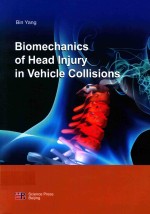图书介绍
汽车碰撞头部损伤生物力学 英文版pdf电子书版本下载

- 羊玢著 著
- 出版社: 北京:科学出版社
- ISBN:9787030512765
- 出版时间:2017
- 标注页数:174页
- 文件大小:28MB
- 文件页数:185页
- 主题词:汽车-碰撞(力学)-头-损伤-生物力学-研究-英文
PDF下载
下载说明
汽车碰撞头部损伤生物力学 英文版PDF格式电子书版下载
下载的文件为RAR压缩包。需要使用解压软件进行解压得到PDF格式图书。建议使用BT下载工具Free Download Manager进行下载,简称FDM(免费,没有广告,支持多平台)。本站资源全部打包为BT种子。所以需要使用专业的BT下载软件进行下载。如 BitComet qBittorrent uTorrent等BT下载工具。迅雷目前由于本站不是热门资源。不推荐使用!后期资源热门了。安装了迅雷也可以迅雷进行下载!
(文件页数 要大于 标注页数,上中下等多册电子书除外)
注意:本站所有压缩包均有解压码: 点击下载压缩包解压工具
图书目录
Chapter 1 Methods in Injury Biomechanics 1
1.1 Statistics,field studies,databases 1
1.2 Injury criteria,injury scales and injury risk 5
1.3 Basic technical definitions and accident reconstruction 8
1.4 Experimental models 13
1.5 Standardized test procedures 18
1.6 Numerical methods 30
Reference 34
Chapter 2 Head Injuries 36
2.1 Anatomy of the head 36
2.2 Injuries and injury mechanisms 38
2.3 Mechanical response of the head 42
2.4 Injury criteria for head injuries 46
2.4.1 Head Injury Criterion(HIC) 46
2.4.2 Head Protection Criterion(HPC) 47
2.4.3 3 ms criterion 48
2.5 Head injuries in sports 48
2.6 Head injury prevention 51
Reference 53
Chapter 3 Development of a Finite Element Head Model for the Study of Impact Head Injury 55
3.1 Segmentation 56
3.2 Models description 61
3.3 Mesh development 63
3.4 Material properties 65
Reference 67
Chapter 4 Validation of the New 3D Finite Element Head Model 71
4.1 Methods and materials 71
4.1.1 Interface conditions in the models 71
4.1.2 Nahum et al.'s experimental impacts 72
4.1.3 Trosseille et al.'s experimental impacts 72
4.1.4 Hardy et al.'s experimental impacts 73
4.2 Results and discussion 74
4.2.1 Impact force and intracranial acceleration response 75
4.2.2 The intracranial pressure(ICP) 76
4.2.3 The maximum von Mises stress in the brain 78
4.2.4 The maximum principal stress in the skull 79
4.2.5 Brain motion 80
4.2.6 Selected future improvement 83
4.3 Pedestrian accident reconstruction 83
4.3.1 Collision model development 83
4.3.2 Simulation result and analysis 84
4.4 Conclusions 86
Reference 87
Chapter 5 Modal and Dynamic Responses of the Human Head-neck Complex for Impact Applications 89
5.1 Introduction 89
5.2 Modal analysis of the finite element model 91
5.2.1 Governing equation and finite element method 91
5.2.2 Development of the 3D finite element head-neck model(FEHM) 92
5.2.3 Validation of the 3D finite element head-neck model 94
5.2.4 Frequency spectrum of the human head-neck complex 95
5.3 Discussion 98
5.3.1 Comparison of fundamental frequency 99
5.3.2 Effect of damping on resonant frequencies and biomechanical responses 100
5.3.3 Comparison of mode shapes 104
5.3.4 Limitations 104
5.4 Summary 105
Reference 105
Chapter 6 Biomechanical Study of the Facial Impact on Pedestrian Traumatic Brain Injury 108
6.1 Introduction 108
6.2 Materials and methods 110
6.2.1 Boundary,loading and contactconditions 110
6.2.2 Result evaluation 111
6.3 Results 112
6.3.1 Stress wave propagation and facial fractures 112
6.3.2 Intracranial biomechanical parameters 124
6.4 Discussion 128
6.5 Summary 130
Reference 130
Chapter 7 Whiplash Injury 134
7.1 Anatomy of the spine 135
7.2 Injury mechanisms 136
7.3 Biomechanical response and tolerances 141
7.4 Injury criteria 143
7.5 Correlating neck injury criteria to the injury risk 144
7.6 Prevention of soft tissue neck injury 146
7.6.1 Head restraint geometry and padding material 147
7.6.2 Controlling head restraint position 149
7.6.3 Controlling seat back motion 150
Reference 151
Chapter 8 Brain Dynamic Responses Due to Wave Propagation 156
8.1 Introduction 156
8.2 Methods and materials 158
8.2.1 Finite element method(FEM) 158
8.2.2 Material properties 159
8.2.3 Boundary conditions 160
8.2.4 Contact and fluid-structure interaction(FSI) 160
8.3 Results and discussion 161
8.3.1 Intracranial pressures(ICP) 161
8.3.2 Skull stress 162
8.3.3 Evaluation on different faceshield configuration 164
8.3.4 Discussion 166
8.4 Conclusions 167
Reference 168
Chapter 9 Conclusions and Recommendations 169
9.1 Validation against three cadaveric experimental data 169
9.2 Modal and dynamic responses 170
9.3 Biomechanical study of the facial impact 170
9.4 Whiplash neck injury 171
9.5 Head injury due to concomitant wave 172
9.6 Recommendation for future work 173
Reference 173